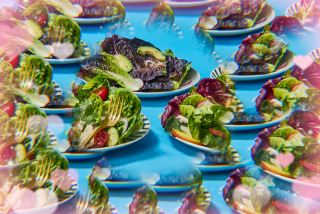Salad industry on hunt for solution to tainted greens
Reporting from Salinas, Calif. — For millions of Americans, bagged salads are a miracle food, the perfect mix of health and convenience.
Time-pressed cooks can rip open a bag and pour the leaves right into the bowl, reassured by the “triple-washed” label that some wondrous process has rendered these greens squeaky clean and ready for dinner.
They don’t want to think about E. coli O157:H7. And the salad industry doesn’t want them thinking about it either.
That’s why the safety of bagged greens has emerged as one of the most pressing issues in today’s fresh produce business. It’s why industry and government are investing millions to avoid debacles such as the death of 30 people last year after eating poorly washed, listeria-laced cantaloupe.
It’s why food companies headquartered in the Salinas Valley, the nation’s salad bowl, are rushing to find the “perfect wash.” They remember too well how, in 2006, local spinach tainted with E. coli O157:H7 killed five people and sent 100 more to the hospital in the worst food poisoning outbreak linked to leafy greens in U.S. history. In and around Salinas, spinach sales still have not recovered from the outbreak, even though no major incident has occurred since.
Today, in the shadow of the mammoth Popeye and Green Giant signs of this agricultural city’s commercial core, an industry food-safety team is readying its latest weapon in the quest for clean salad greens.
Its unofficial name is T-128, and it fills hundreds of canisters stacked in a warehouse behind unmarked offices on a side street. Trucks shuttle T-128 to bustling commercial processing plants down the street and to faraway cities to help wash romaine, spinach and other greens before they’re bagged and shipped.
Also known as SmartWash, T-128 is basically a new industrial salad wash additive. It can reduce the risk of bacteria spreading from leaf to leaf during washing, says Jim Brennan, president of New Leaf Food Safety Solutions, the food safety subsidiary of industry giant Taylor Fresh Foods.
T-128 is the brainchild of Brennan’s Skunk Works-style research team, which is studying its effectiveness on cantaloupes. It may not be the ultimate solution. But Brennan believes it’s getting the industry closer.
Other researchers are looking at chlorine alternatives, gaseous washes, ultrasound, radiation, even cold plasma — any means to strip that last germ from a leaf of baby spinach or endive or the popular spring mix.
Like most fresh vegetables, leafy greens sprout close to the earth in open fields. That makes them susceptible to bacteria from soil or irrigation water or roaming wild animals.
Even though Salinas Valley farmers have instituted a gamut of widely praised post-2006 reforms, it’s impossible to stop all pathogens from landing on lettuce and spinach leaves. “The farmer can’t control every square inch, every minute of the day, and see every mouse that runs through,” said Patrick Kennelly, chief of food safety at the California Department of Public Health.
And green leaves are simply too fragile to be scrubbed as you might treat an apple or a squash.
The easiest way to make those greens safe? Cook them. Treat them like meat, heating them to 160 degrees to kill off E. coli and other pathogens. “But with leafy greens, if you did that, it would turn into melted nothing,” Kennelly said.
So the perfect wash is high on the agenda for food companies and their scientists.
This new concern follows decades of business-as-usual on the part of farmers and packaging firms. “Clearly, the science was behind, and some people think it’s still behind,” said food safety expert Robert Gravani, a Cornell University food science professor.
One of the biggest hurdles facing scientists now is how salad bagging works.
Thousands upon thousands of salad leaves are taken to a central plant, washed together, bagged and shipped. Even if only a few leaves are tainted, harmful pathogens can spread in the wash water — the modern salad version of the old adage that one bad apple spoils the whole barrel.
“I would think of it as swimming in a swimming pool in Las Vegas with a thousand people I didn’t know,” said William Marler, a prominent Seattle-based food safety attorney whose work began with the 1993 Jack in the Box E. coli outbreak that sickened hundreds and killed four. Since then, he has represented thousands of victims and families in major outbreaks linked to hamburger, peanut butter, spinach and cantaloupe, among others.
If tainted leaves make it to the processing plant, salad companies have to remove the pathogens, which is harder than it might seem. “The problem with produce is that once it’s contaminated, especially fresh-consumed produce, it’s extremely hard to get off,” said Randy Worobo, a Cornell University associate professor of food microbiology.
Earthbound Farm of San Juan Bautista, another Salinas-area salad powerhouse, also is investing heavily in food safety.
The company faced a steep climb to win back consumer confidence. In 2006, it processed the spinach, sold under the Dole label, that spread the deadly E. coli to 26 states.
Besides the five people who died, 31 people developed a serious illness linked to E. coli that can cause kidneys to fail. The illness,hemolytic-uremic syndrome, or HUS, is most common in children, and 29% of those sickened after eating Salinas Valley spinach were younger than 18.
Investigators traced the E. coli to a single 50-acre field at the Paicines Ranch in San Benito County. Wild pigs may have tracked it from cattle grazing nearby, since E. coli typically lives in mammals’ intestines, officials said.
That a portion of a single field could sicken so many people was a harsh lesson for the bagged salad industry. Will Daniels, Earthbound’s senior vice president for food safety, believes that the E. coli may have been contained in a single 500-pound lot of spinach.
So scientists are delving deep into the biology of leafy greens to learn exactly how a pathogen clings to a leaf, and how to get it off.
That’s tougher than it might seem.
Most companies treat their salad wash water by adding an antimicrobial agent, typically chlorine. Ideally, a rinse in clean, chlorinated water would whisk off those pathogens and prevent them from migrating to other leaves. But tiny amounts of pathogens can survive those washes and taint clean leaves.
Taylor Fresh’s T-128 has been shown in studies to boost the power of chlorinated water. Fresh Express, meanwhile, developed its own Fresh Rinse, a chlorine alternative, and Earthbound is testing chlorine-free cleansers with a citrus base, citing concerns about the potential environmental problems linked to chlorine.
Even so, a simple rinse can’t easily remove pathogens if they’ve become embedded in so-called biofilms — thin, microscopic layers that can be formed by bacteria like E. coli and salmonella.
“You have this gooey mass, like frosting on top of a cantaloupe surface or a leaf surface,” said Trevor Suslow, a UC Davis food safety researcher. “They’re hard to penetrate by antimicrobials. They’re glued on pretty tightly.”
And so “biofilm disrupters” are a popular topic among researchers trying to pull pathogens from greens.
Daniels of Earthbound Farm is especially enthusiastic when he describes high-power ultrasound tests his firm is funding at the Institute for Food Safety and Health, part of the Illinois Institute of Technology.
The institute outside Chicago is one of only a handful of U.S. food safety centers with a test processing plant ranked Biosafety Level 3, or BSL-3, in which scientists must wear moon suits for certain experiments and are decontaminated before they leave the lab. It’s designed to test the behavior of live, potentially lethal pathogens on foods, be they sprouts, eggs or ready-to-eat meals.
The high-power ultrasound works like a factory-scale bubbling denture cleanser. Researchers use it to create millions of tiny bubbles that cover leaf surfaces. When the bubbles burst, they release enormous energy that can dislodge pathogens into water treated with highly acidic citrus cleanser — a one-two punch that Daniels says is yielding promising results.
Gas washes are also catching the attention of food companies, perhaps applied while post-harvest greens are stored in coolers before processing.
Even the best research can’t reduce the risk of contaminated greens by 100%, scientists said. At Earthbound, Daniels says the ultimate goal is to achieve what scientists call a “5 log reduction,” the equivalent of pasteurizing milk. In short, if an unwashed lettuce contained 100,000 pathogens, the perfect wash system would knock off five “0s” and reduce the pathogen count to 1.
Plenty of money is being tossed at the problem of tainted greens. The Center for Produce Safety at UC Davis, founded in response to the spinach outbreak as an industry-public partnership, has pumped more than $9 million into 54 research projects at 18 universities, according to Executive Director Bonnie Fernandez-Fenaroli.
But even if the perfect wash-treatment combo emerges, some experts wonder how much companies would be willing to pay for it.
Microbiology professor Michael Doyle, director of the Center for Food Safety at the University of Georgia, has consulted with some of the nation’s leading food companies for decades.
“There’s an elite group that’s committed to food safety,” he said. “Then there are others that don’t want to spend a lot on food safety unless they’re forced to by theMcDonald’sof the world.”
Deborah Schoch is a senior writer at the California HealthCare Foundation Center for Health Reporting, an independent news organization devoted to reporting about health care issues that concern Californians. The Center is based at the USC Annenberg School for Communication & Journalism. It is funded by the nonpartisan California HealthCare Foundation, one of two health foundations created by the privatization of Blue Cross of California in 1996.
More to Read
Eat your way across L.A.
Get our weekly Tasting Notes newsletter for reviews, news and more.
You may occasionally receive promotional content from the Los Angeles Times.










